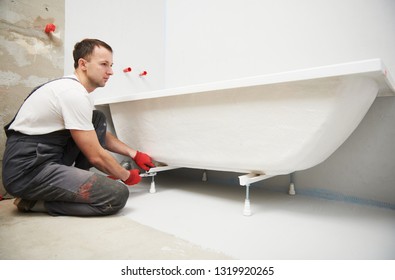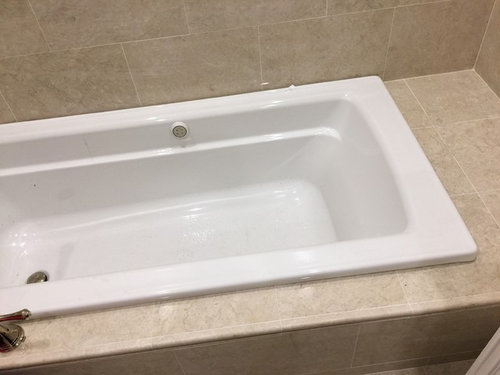What are your thoughts concerning A Step-by-Step Guide to Installing a Bathtub?

Mounting a tub isn't specifically brain surgery, however it does require solid plumbing, carpentry, and also occasionally, tiling skills. Replacing an old bathtub with a new one is also a moderately challenging job. If the old tub is readily accessible, the project can relocate easily; if you have to open a wall to eliminate the old bathtub as well as position the new bathtub, the task is a lot harder. In either instance, the task is within a house handyman's skills, although you will require an assistant to vacate the old tub and also embeded in the new one. Make sure you have actually certified yourself for the work as well as fit attempting it. As opposed to working with a service provider to take control of a halfway-completed task, it is better to consider utilizing one before you begin. Chances are you might require an expert plumber to make tube connections.
This short article will help you install a brand-new tub in your bathroom if you have actually currently purchased a new bathtub as well as don't need to alter the arrangement of your previous water supply pipes.
Your tools as well as product list need to comprise the following:
Planning for the Installment
To start with, the supporting structure provided with the bathroom must be fitted (if needed) according to the producer's instructions. Next, fit the faucets or mixer to the tub. When suitable the faucet block, it is very important to make certain that if the tap features a plastic washing machine, it is fitted between the bathroom as well as the faucets. On a plastic bath, it is additionally reasonable to fit a supporting plate under the faucets device to prevent stress on the bathtub.
Fit the flexible faucet connectors to the bottom of both taps making use of 2 nuts as well as olives (in some cases provided with the tub). Fit the plug-hole electrical outlet by smearing mastic filler round the sink outlet opening, and then pass the outlet via the hole in the bath. Utilize the nut supplied by the supplier to fit the plug-hole. Analyze the plug-hole electrical outlet for an inlet on the side for the overflow pipeline.
Next, fit the end of the versatile overflow pipeline to the overflow electrical outlet. After that, screw the pipeline to the overflow face which should be fitted inside the bath. Ensure you utilize every one of the provided washing machines.
Connect the trap to the bottom of the waste outlet on the bathtub by winding the string of the waste electrical outlet with silicone mastic or PTFE tape, and also screw on the catch to the electrical outlet. Attach all-time low of the overflow tube in a comparable manner.The bathroom must currently prepare to be suited its last setting.
Removing Old Taps
If you need to replace old faucets with brand-new ones as a part of your installment, after that the first thing you need to do is separate the water system. After doing so, switch on the taps to drain pipes any kind of water staying in the system. The process of getting rid of the existing faucets can be fairly troublesome due to the limited gain access to that is often the case.
Make use of a basin wrench (crowsfoot spanner) or a faucet tool to undo the nut that attaches the supply pipes to the faucets. Have a cloth prepared for the staying water that will originate from the pipelines. Once the supply pipelines have actually been gotten rid of, utilize the same device to loosen the nut that holds the faucets onto the bath/basin. You will require to stop the single faucets from turning throughout this process. When the faucets have been gotten rid of, the holes in the bath/basin will have to be cleansed of any old sealing substance.
Before carrying on to fit the new taps, compare the pipe connections on the old faucets to the brand-new taps. If the old taps are longer than the brand-new faucets, then a shank adapter is required for the brand-new faucets to fit.
Mounting the Bath tub
Making use of both wood boards under its feet, position the bath tub in the needed setting. The wood boards are helpful in evenly spreading out the weight of the bath tub over the location of the boards rather than focusing all the weight onto four little factors.
The following objective is to ensure that the bathtub is leveled all round. This can be accomplished by inspecting the spirit level as well as readjusting the feet on the bathtub till the spirit level reads degree.
To mount faucets, fit the bottom of the outermost adaptable faucet connector to the appropriate supply pipeline by making a compression join; then do the exact same for the other faucet.
Switch on the water system and examine all joints as well as new pipework for leakages as well as tighten them if necessary. Fill up the bath tub and likewise check the overflow outlet and also the normal electrical outlet for leakages.
Finally, take care of the bathroom paneling as defined in the manufacturer's instruction manual. Tiling and also sealing around the bath tub should wait until the tub has been utilized at the very least once as this will settle it into its last setting.
Suitable New Touches
If the tails of the brand-new faucets are plastic, after that you will certainly require a plastic adapter to stop damages to the string. One end of the adapter fits on the plastic tail of the tap and also the other end offers a connection to the current supply pipelines.
If you require to fit a monobloc, after that you will call for lowering couplers, which links the 10mm pipe of the monobloc to the typical 15mm supply pipe.
Next, place the faucet in the placing opening in the bath/basin making sure that the washing machines remain in area in between the tap and the sink. Protect the tap in place with the supplier supplied backnut. Once the faucet is securely in position, the supply pipes can be attached to the tails of the taps. The faucets can either be connected by using corrugated copper piping or with regular tap ports. The former type needs to be connected to the faucet finishes first, tightening up just by hand. The supply pipelines can later be linked to the various other end. Tighten both ends with a spanner after both ends have been attached.
Tiling Around the Bathtub
In the area where the bath satisfies the floor tile, it is essential to seal the joins with a silicone rubber caulking. This is necessary as the fitting can move sufficient to break a rigid seal, causing the water to pass through the wall in between the bathroom as well as the tiling, causing issues with wetness and also feasible leaks to the ceiling below.
You can choose from a variety of coloured sealers to assimilate your components and fittings. They are marketed in tubes and also cartridges, as well as are capable of securing gaps approximately a size of 3mm (1/8 inch). If you have a larger void to fill up, you can fill it with spins of soaked paper or soft rope. Keep in mind to constantly fill the bath tub with water before securing, to enable the movement experienced when the tub remains in use. The sealant can fracture fairly very early if you do not take into account this movement prior to sealing.
Conversely, ceramic coving or quadrant ceramic tiles can be made use of to edge the bathroom or shower tray. Plastic strips of coving, which are easy to use and reduce to size, are additionally easily readily available on the market. It is a good idea to fit the floor tiles using waterproof or water-proof adhesive as well as grout.
Bathtub Installation
How Important Is A Bathtub To Your Home?
High-quality baths, showers, and other bathroom updates are necessary when considering a smart investment in your home. It’s a room that you go to every day and one that is constantly being used by guests.The bathroom is one of the top trafficked rooms in a home and also one of the most valuable in terms of home resale.
Install Piping Before Tub
You will be using your existing drain and waste vent system, but pipes required include the hot and cold water supply lines and a pipe leading to a shower head. A mixing valve and shower head are also needed. Air chambers may be required.
Position the Tub
Lower the tub into place so that the continuous flange fits against the wall studs and rests on 1’x4' or 2’x4' supports. Anchor the tub to the enclosure with nails or screws inserted through the flanges into the studs.
NOTE: Remember, bathtubs and shower stalls may require support framing. A bathtub filled with water is extremely heavy, so check building codes and framing support before installing the tub.
Assemble Drain Connections
Assemble the bathtub drain connections by connecting the tub overflow with the tub drain above the trap, not beyond it. The trap will have a compression fitting that screws over the arm of the overflow assembly.
Place a Pipe For the Shower Head
First, locate a brass female threaded winged fitting and attach it to a framing support via a screw or a nail. Then run a pipe up the wall for the shower head. Sweat or solder the other side of the brass fitting to the top of the pipe.
Attaching Hot and Cold Water Lines
Attach your water lines for both hot and cold by sweating these directly into the hot and cold ports of the mixing valve. The mixing valve will be how water enters the tub’s system, not by the pipes themselves.
Install the Spout
Extend a piece of 1/2 inch pipe, or whichever length is specified in the manufacturer’s instructions, for the tub spout. Sweat on a male threaded fitting at the end of the pipe or use a brass nipple of the proper length and a 1/2 inch cap.
NOTE: At this point you should have your rough-in plumbing work inspected before proceeding further.
Check For Leaks
Restore the water pressure and check the drain connection and the supply pipes for any sign of leaking.
estore the Bathroom Wall
Replace the wall with moisture-resistant drywall as a base for your wall covering. Seal the joints between the wall and your new tub with silicone caulk as protection against water seepage.
https://www.berkeys.com/2016/12/02/bathtub-installation-dallas/

I came across that blog entry about Tools You Need to Install a New Bathtub while doing a search on the search engines. Appreciated our content? Please share it. Let other people locate it. Thanks a lot for taking the time to read it.
We're here for you, dial!